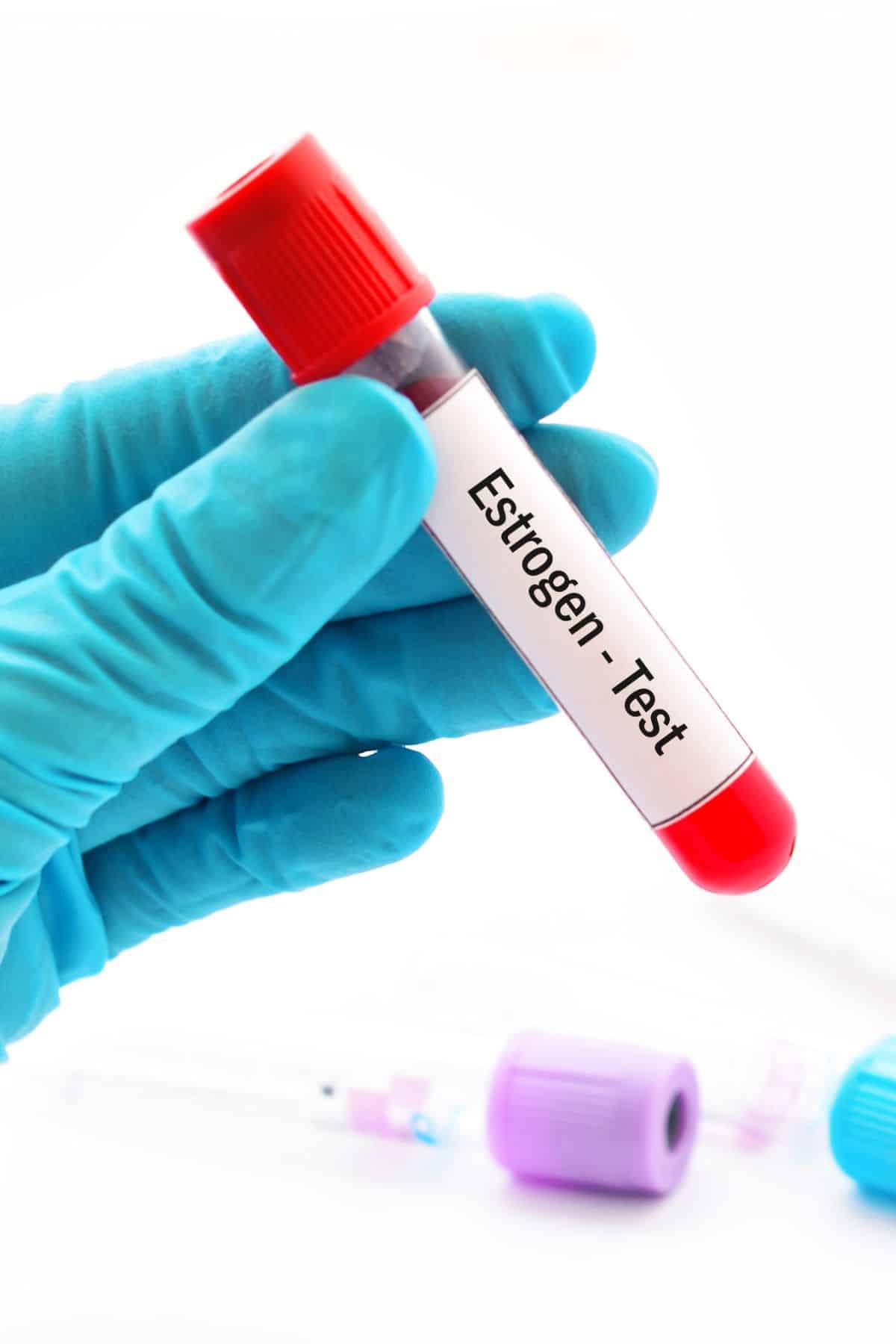25+ Estrogen Dominance Symptoms (& What to Do About It)
Estrogen dominance can occur at any point in a woman’s lifetime, although it is most common during childbearing years and perimenopause. Here are the symptoms of estrogen dominance in women, plus some natural ways to reduce it for overall health.

Overview of Estrogen
Estrogen is an important hormone associated with a wide range of functions in the body.
Some of them – such as contributing to ovulation, regulating the menstrual cycle, and promoting the growth of the womb’s lining – you are probably familiar with.
But estrogen has other essential roles that you might not have considered. These include:
- Supporting the metabolism
- Helping with mental cognition
- Promoting a healthy sex drive
- Protecting the heart, cardiovascular system, and bones
- Promoting healthy skin and hair
When your levels of estrogen are high in relation to your levels of progesterone (another reproductive hormone), estrogen dominance results.
And, because estrogen is connected to so many processes in your body, that hormonal imbalance can have far-reaching effects that may cause a wide range of symptoms.
How Estrogen Gets Unbalanced
So just what causes your estrogen levels to become too high in the first place? Well, the reason may be down to one or more of a variety of factors:
Poor Liver Health or Gut Health Issues
Estrogen is metabolized in the liver, a process that needs certain vitamins and minerals.
If your body is lacking these essential nutrients, then the liver is unable to process estrogen properly.
Poor gut health can play a part, too, as it’s your gut that is responsible for eliminating estrogen from the body. If you are constipated, you may reabsorb excess estrogen instead of expelling it, pushing your levels too high.
Another problem can be the overproduction of an enzyme called beta-glucuronidase. This, too, can cause estrogen that should have been eliminated to be recirculated through the bloodstream.
Chronic Stress
When your body is in a state of stress, your adrenal glands produce cortisol in response. This increases your heart rate and blood pressure, forming part of the “fight or flight” response.
But this is only healthy in the short term.
If stress persists long-term, a condition known as “adrenal fatigue” may develop. While not recognized as a medical condition, some people believe that it can cause progesterone levels to drop. This is because progesterone is used to produce more cortisol and other stress hormones.
When progesterone levels drop and you have low progesterone levels, estrogen levels become too high in comparison.

Environmental Toxins & Phytoestrogens
Known as xenoestrogens, environmental toxins are everywhere, from tap water and artificial food dyes to plastics and sunscreen.
They behave like the natural estrogens in our body but are more powerful, therefore contributing to estrogen dominance.
Certain foods – like flax, soy, and many other plant-based foods – can be a problem, too. See the foods to avoid with estrogen dominance.
This is because they are high in phytoestrogens – natural compounds that mimic the estrogen in our bodies. A diet that contains too many of these foods can raise our overall estrogen levels.
Perimenopause
As you approach menopause, your progesterone levels drop and ovulation begins to slow down. This then causes your estrogen levels to become too high relative to progesterone, leading to estrogen dominance.
Other Causes
Other factors that can cause your estrogen levels to become too high include:
- Certain medications, including some antibiotics and drugs used to treat mental health conditions
- Contraceptives
- Hormone replacement therapy
- Certain herbal remedies
It’s also possible for high estrogen levels to run in families.
Estrogen dominance symptoms
1. Irregular periods
Probably the most noticeable symptom caused by imbalanced hormonal levels is a disruption to the menstrual cycle.
That’s because estrogen plays such an important part in its regulation and even the slightest change in your levels can have an impact.
This means that you may experience periods either less or more often, or that their duration may change. This can affect reproductive health and fertility.
2. Heavy or painful periods
In addition to becoming irregular, periods may become heavier or more painful if you have signs of estrogen dominance or not enough progesterone.
Normally, it is the job of estrogen to promote the growth and thickening of the lining of the uterus. But when your estrogen levels get too high, the lining builds up too much, and heavier periods result.
3. Premenstrual Syndrome (PMS)
If you are suffering from estrogen dominance, then the symptoms of premenstrual syndrome can become exaggerated.
This is because excess estrogen is circulating around your body just before your menstrual cycle, causing feelings of anxiety, anger, and low mood.
4. Breast tenderness or swelling
You might notice that your breasts feel more full and/or become tender before your period or when you are ovulating.
This is a response to changing estrogen levels during the menstrual cycle and may also be caused by an increased sensitivity to estrogen.

5. Fibrocystic breasts
Fibrocystic breast disease isn’t really a disease at all and is simply a term used to describe lumpy, painful breasts during – or just before – a period.
In some cases, you can feel a lump that feels larger just before your period and that shrinks again afterward (although you should always discuss any lumps in the breast with your medical provider).
Sometimes the pain from fibrocystic breasts can be felt under the arms, too.
The condition is very common and is usually diagnosed via an ultrasound scan. It happens when breast tissues become thicker (fibrosis) and cysts filled with fluid develop in one or both of the breasts.
Elevated estrogen levels or poor estrogen metabolism are thought to be responsible for these changes.
6. Mood swings
One of estrogen’s many jobs is to regulate our moods, so changing estrogen levels can lead to sudden – and sometimes dramatic – changes in the way we feel.
Mood swings and irritability caused by estrogen dominance can happen at any time of the month – not just around the time of your period.
7. Depression and anxiety
Studies have shown that elevated estrogen levels may make you feel anxious because they increase the stimulation of certain estrogen receptors responsible for anxiety symptoms.
Anxiety is more intense than simple worry – it can cause tightness in the chest and a racing heart, sometimes culminating in panic attacks.
Experts have also noted that women are twice as likely as men to experience the symptoms of depression.
They believe this is because estrogen regulates the production of a hormone called serotonin, often referred to as the “happy hormone” because it helps promote a positive frame of mind.
Too much estrogen is known to have a negative effect on serotonin production, which explains why depression is a common side effect of medications like hormone replacement therapy or contraception.
8. Fatigue and lack of energy
There are multiple reasons for fatigue when your estrogen levels are high.
For one thing, it can be difficult to get a good night’s sleep and insomnia is a common problem (see below).
This is compounded by the anxiety that estrogen dominance can bring on. Other symptoms, too, can make life challenging, leaving you feeling exhausted and depleted in motivation by the end of the day.

9. Headaches
It may seem strange but there is a strong relationship between your estrogen levels and headaches.
Headaches caused by hormones (often referred to as menstrual headaches) usually occur at around the time of your period and experts acknowledge that any change to your estrogen levels can trigger them.
10. Insomnia
Estrogen helps regulate the production of melatonin, the hormone that plays an important role in the circadian sleep-wake cycle.
That means that fluctuating estrogen levels can lead to insomnia, contributing to an overall feeling of fatigue throughout the day.
11. Weight gain, especially around the hips and thighs
One of estrogen’s main roles is to encourage the body to deposit fat in certain areas in order to promote the classic female body composition – breasts, wider hips, and larger buttocks.
However, when your estrogen levels are too high, you may begin to gain weight, particularly in these key areas.
Weight gain due to estrogen dominance may be influenced by other factors, too, such as low mood, exhaustion, and a lack of motivation to exercise.
12. Water retention and bloating
Estrogen plays a part in water retention and if your levels of estrogen are too high, your body might retain more water than usual.
That’s why you may have noticed that you tend to get more bloated around the time of your period.
With estrogen dominance, however, this bloating can become much more frequent and make life quite uncomfortable.

13. Brain fog and difficulty concentrating
Brain fog can be tough to deal with. It makes your thoughts fuzzy and even the most simple concepts can be hard to grasp. It can also lead to forgetfulness and make it very hard to concentrate.
These symptoms tend to result from the effects of the other symptoms of estrogen dominance, particularly lack of sleep, depression, and fatigue.
14. Memory problems
Experts have found that estrogen affects the development and aging of the parts of the brain responsible for memory.
In the early stages, this can cause mild forgetfulness, but it can worsen over time. So severe can the effects of estrogen dominance be on memory that the symptoms can be mistaken for the early stages of Alzheimer’s disease or dementia.
15. Decreased sex drive
Many women report a distinct drop in libido when their estrogen levels are high and science confirms that fluctuating hormones can have a significant impact on the desire for sex.
But the other symptoms on this list – including weight gain, bloating, exhaustion, and mood swings – can play a big part in contributing to a low sex drive, too.
16. Fibroids
Uterine fibroids are benign (non-cancerous) tumors that grow in the uterus. They are considered to be estrogen dependent, which means they need estrogen to grow.
Too much estrogen can, therefore, stimulate their growth – a problem that is particularly common in women during perimenopause.
17. Endometriosis
Endometriosis is a condition in which cells similar to the endometrium (lining of the uterus) grow outside the womb.
One particular type of estrogen – estradiol – regulates how these cells grow. When estrogen levels are high, painful endometriosis adhesions can form.
Women with endometriosis are usually given medication to lower their estrogen levels in order to relieve the symptoms.
18. Ovarian cysts
When the reproductive system is working as it should, the ovaries receive a message from the reproductive hormones to release an egg.
When the hormones are not properly balanced, however, the signal is disrupted, meaning the egg may not be released on time – or at all.
This can result in the development of a cyst, where the follicle containing the egg begins to swell. Other cysts may develop, too, eventually causing problems like heavy or irregular periods, weight gain, and acne.
19. Acne or skin issues
Acne, pimples, and other skin issues may typically be considered a teenage problem, but fluctuating estrogen levels can cause breakouts in later life too.
Other changes attributed to estrogen levels can include pigmentation, red marks known as spider angiomas, and reddening of the palms (palmar erythema).
20. Hair loss or thinning
While there is no clear medical explanation, some women find they lose more hair than usual when their estrogen levels are elevated.
Other problems include hair feeling thinner and weaker, or just not looking as healthy as it used to.
21. Excessive facial hair growth
Estrogen dominance can disrupt the hormonal balance in women. This imbalance can lead to hirsutism, characterized by excessive hair growth.
Women may notice thicker hair in uncommon areas such as the face, chest, and abdomen. Such unexpected hair growth can be emotionally distressing for those affected.
Rebalancing hormone levels and finding the root cause of the causes of estrogen dominance can help resolve this and the other symptoms.
22. Digestive problems, such as constipation or bloating
Although there has been no research on humans, studies using animals have shown that high levels of estrogen can trigger constipation.
This is because the presence of estrogen can slow down the movement of waste through the digestive system.
This is why it’s so important to eat a variety of fiber-rich foods on a daily basis. See my healthy food shopping list if you need help with what to buy.
23. Allergies and asthma
Several female hormones seem to be linked to allergic reactions but estrogen is the most well-studied.
It is believed to be because of estrogen that asthma is much more common – and severe – in women than it is in men. Scientists also think that the actions of estrogen affect the body’s immune response in a way likely to trigger allergic reactions.

24. Autoimmune diseases
There is research to suggest that women who have been on oral birth control or hormone replacement therapy for an extended period may be more prone to autoimmune conditions like rheumatoid arthritis and lupus
This indicates that high levels of estrogen may stimulate antibodies to produce an autoimmune response.
25. Insulin resistance and diabetes
When the hormones are properly balanced, the levels of sugar in the blood are stabilized.
This means that there is a risk of insulin resistance and diabetes if estrogen becomes the dominant hormone.
Another contributing factor can be the weight gain associated with estrogen dominance.
Natural Ways to Address Estrogen Dominance
Fortunately, there are many simple steps you can take to resolve estrogen dominance naturally and get rid of the most common symptoms.
And, the good news is that these lifestyle changes can improve your health in other ways, too, leaving you feeling better in general!
Learn to manage stress
Stress is an inevitable part of everyday life but there are ways in which you can get it under control.
These include:
- Making time for yourself, to do activities you really enjoy
- Discussing your feelings with friends and family, and not being afraid to ask for support
- Limiting your time on social media and watching/reading news reports
- Trying to cut out unhealthy habits like drinking and smoking
Work on improving the quality of your sleep
Insomnia is tough to deal with but there are practical steps you can take to help get a good night’s sleep.
- Try to go to bed and wake up at the same time every day
- Avoid eating a big meal, drinking alcohol or coffee, or smoking too close to bedtime
- Turn off all screens at least 30 minutes before going to bed
- Ensure your bedroom is dark, well-ventilated, and quiet. If noise is an issue, consider playing ambient sounds – there are lots of apps available for this

Eat healthy with lots of fiber
Aim to eat clean by cutting out processed foods and regularly cooking from scratch with fresh, whole ingredients.
Ensure you include plenty of fruits and vegetables in your diet. These are high in fiber and will help keep your bowel movements regular – an important part of expelling excess estrogen from the body.
Try to avoid conventionally raised meat as it can contain hormones. Instead, opt for organic, grass-fed meat wherever possible.
Discuss the possibility of taking supplements to improve the metabolism of estrogen in the liver with your healthcare provider.
Exercise regularly
Going to the gym is great but exercise comes in many forms!
If you struggle with motivation, find something you really enjoy that keeps you moving – dancing, for example, or cycling with family and friends.
Estrogen Dominance FAQs
Estrogen dominance cannot be reversed overnight, but you can expect to see improvements within 3 to 4 months of making the appropriate changes to your lifestyle and diet. You should consult with a healthcare provider who can help you monitor your hormone levels and find the root cause of any causes of estrogen dominance.
Estrogen dominance refers to the levels of estrogen in the body relative to progesterone. This isn’t necessarily an indication that the levels of progesterone in the body are too low.
Estrogen is typically considered a female hormone, but the male body makes it too.
The right balance of estrogen and testosterone is important for men and an imbalance can lead to problems with sexual development and function.
These include infertility, erectile dysfunction, and the development of breasts (gynecomastia).
Don’t Miss These Hormone Articles!
Conclusions
Because your body uses estrogen in so many different ways, too much of it can trigger a wide variety of symptoms that may make daily life a struggle.
The good news, however, is that estrogen dominance is a reversible problem. These simple improvements to your diet and lifestyle can help balance your hormones, enhance your health, and give your sense of well-being a significant boost!
About the Author: Carrie Forrest has a master’s degree in public health with a specialty in nutrition. She is a top wellness and food blogger with over 5 million annual visitors to her site. Carrie has an incredible story of recovery from chronic illness and is passionate about helping other women transform their health. Send Carrie a message through her contact form.
Note: this post is for informational purposes only and is not intended as medical advice. Please consult your healthcare provider for recommendations related to your individual situation.
























